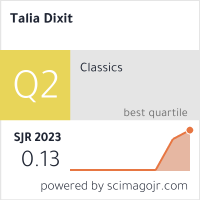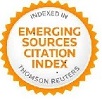Nuevas aportaciones metodológicas a la retórica e historiografía tardo-antiguas
Palabras clave:
Antigüedad tardía, Retórica, Historiografía, Cristianismo, PaideiaResumen
Este trabajo pretende analizar el panorama bibliográfico actual sobre los estudios de retórica e historiografía del mundo tardo-antiguo. Tras un breve esbozo de las metodologías empleadas hasta el momento, se prestará especial atención a las recientes publicaciones de S. Elm y deR. Cribiore, dos trabajos que ofrecen nuevas perspectivas metodológicas en el análisis de las obras de figuras clave (el emperador Juliano, Gregorio de Nacianzo y Libanio de Antioquía) en el contexto político, religioso y culturaldel siglo IV
Descargas
Referencias
CAMERON, AV. (1991), Christianity and the Rhetoric of the Empire: The Development of Christian Discourse, Berkeley: University of California Press.
____ (2014), Dialoguing in Late Antiquity, Washington D.C.: Center for Hellenic Studies.
CLARE, A. (1927), The Language and Style of the Letters of St. Basil, Washington D.C.: Catholic University of America.
CRIBIORE, R. (2001), Gymnastics of the Mind: Greek Educationin Hellenistic and Roman Period, Princeton: University of Princeton.
____ (2013), Libanius the Sophist. Rhetoric, Reality, and Religion in the Fourth Century, Ithaca: Cornell University Press.
ELM, S. (2012), Sons of Hellenism, Fathers of the Church. Emperor Julian, Gregory of Nazianzus, and the Vision of Rome, Berkeley: University of California Press.
ENGELS, D. y VANNUFFELEN, P. (eds.) (2014), Religion and Competition in Antiquity, Bruselas: Latomus.
FOX, M. (1939), The Life and Times of St. Basil the Great as Revealed in His Works, Washington D.C.: Catholic University of America.
GARNSTEIN, B. (2006) Saving Persuasión: a Defence of Rhetoric and Judgement, Cambridge MA: Harvard University Press.
JACK, L.V. (1922), St. Basil and Greek Literature, Washington D.C.: Catholic University of America.
JONES, C.P. (2012), “The “Fuzziness” of Paganism”, Common Knowledge18:2, 249-254.
LIM, R. (ed.) (1995), Public Disputation, Power, and Social Order in Late Antiquity, Berkeley: University of California Press.
MARKUS, R. (1994), “How on Earth could places become Holy? Origins of the Christian idea of Holy Places”, Journal of Early Christian Studies 2.3: 257-71.
MARSHALL CAMPBELL, J. (1922), The Influence of the Second Sophistic on the Style of the Sermons of St. Basil the Great, Washington D.C.: Catholic University of America.
MCLYNN, N. (1994), Ambrose of Milan: Church and Court in a Christian capital, Berkeley: University of California Press.
NEIL, C. y LOSEBY, S. (eds.) (1996), Towns in Transition. Urban Evolution in Late Antiquity and the Early Middle Ages, Aldershot: Scolar
ROUSSEAU, P. (1994), Basil of Caesarea, Berkeley: University of California Press.
SHEPARDSON, C. (2014), Controlling Contested Places: late Antique Antioch and the Spatial Politics of Political Controversy, Berkeley: University of California Press.
TORRES GUERRA, J. (2014), “La literatura griega cristiana: una perspectiva clásica”, Estudios Clásicos 145, 71-94.
VAN HOOF, L. (ed.) (2014), Libanius. An Introduction, Cambridge: Cambridge University Press.
VAN NUFFELEN, P. (2014), “Not the last pagan: Libanius between elite rhetoric and religion”, en L. van Hoof (ed.) (2014), Libanius. An Introduction, Cambridge: Cambridge University Press, 293-314
VICKERS, B. (1988), In Defence of Rhetoric, Oxford: Clarendon Press.
WATTS, E. (2015), The Final Pagan Generation, Berkeley: University of California Press.












